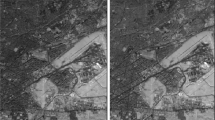Abstract
A new procedure supporting filtering and classification of LiDAR data based on both elevation and intensity analysis is introduced and validated. After a preliminary analysis to avoid the trivial classification of homogeneous datasets, a non-parametric estimation of the probability density function is computed for both elevation and intensity data values. Some statistical tests are used for selecting the category of data (elevation or intensity) that better satisfies a bi- or a multi-modal distribution. The iterative analysis of skewness and kurtosis is then applied to this category to obtain a first classification. At each step, the point with the highest value of elevation (or intensity) is removed. The classification is then refined by studying both statistical moments of the complementary data category, in order to look for potential sub-clusters. Remaining clusters are identified by applying the same iterative procedure to the still unclassified LiDAR points. For more complex point distribution shapes or for the classification of large scenes, a progressive analysis is proposed, which is based on the partitioning of the entire dataset into more sub-sets. Each of them is then independently classified by using the core procedure. Some numerical experiments on real LiDAR data confirmed the potentiality of the filtering/classification method.


























Similar content being viewed by others
References
Axelsson P (2000) DEM extraction from laser scanner data using adaptive TIN models. Int Arch Photogramm Remote Sens 33(B4):110–117
Bao Y, Cao C, Chang C, Li X, Chen E, Li Z (2007) Segmentation to the clouds of LIDAR data based on change of Kurtosis. Proc of SPIE. doi:10.1117/12.791521, International Symposium on Photoelectronic Detection and Imaging 2007: Image Processing, edited by Liwei Zhou, Vol. 6623, 66231N
Bao Y, Cao C, Zhang H, Chen E, He Q, Huang H (2009) Synchronous estimation of DTM and fractional vegetation cover in forested area from airborne LIDAR height and intensity data. Sci China Ser E 51(2):176–187
Bartels M, Wei H (2006) Segmentation of LIDAR Data using measures of distribution. Int Arch Photogramm Remote Sens Spat Inf Sci 36(7)
Bartels M, Wei H (2010) Threshold-free object and ground point separation in LIDAR data. Pattern Recogn Lett 31:1089–1099
Bartels M, Wei H, Mason D (2006) DTM Generation from LIDAR Data using Skewness Balancing. In: Proc. of ‘18th Int. Conference on Pattern Recognition (ICPR’06),’ Vol. 1, Hong Kong, China S.A.R., 20–24 Aug 2006, pp. 566–569
Costantino D, Angelini MG (2011) Features and ground automatic extraction from airborne LiDAR data. Int Arch Photogramm Remote Sens Spat Inf Sci 38(5/W12)
Crosilla F, Macorig D, Sebastianutti I, Visintini D (2011) Points classification by a sequential higher—order moments statistical analysis of LIDAR data. Int Arch Photogramm Remote Sens Spat Inf Sci 38(5/W12)
Duda RO, Hart PE, Stork DG (2001) Pattern classification. Wiley & Sons, New York, USA
Epanechnikov VA (1969) Non-parametric estimation of a multivariate probability density. Theor Probab Appl 14:153–158
Forlani G, Nardinocchi C, Scaioni M, Zingaretti P (2006) Complete classification of raw LIDAR data and 3D reconstruction of buildings. Pattern Anal Appl 8(4):357–374. doi:10.1007/s10044-005-0018-2
Haralick RM, Shapiro LG (1992) Computer and robot vision. Addison-Wesley, Boston
Hartigan JA, Hartigan PM (1985) The dip test of unimodality. Ann Stat 13(1):70–84
Johnson NL, Kotz S, Balakrishan N (1994) Continuous univariate distributions, vol 1, 2nd edn. Wiley, New York
Kim TH, White H (2004) On more robust estimation of skewness and kurtosis. Financ Res Lett 1(1):56–73
Kraus K, Pfeifer N (1998) Derivation of digital terrain models in wooded areas. ISPRS J Photogramm 53(4):193–203
Liu Y, Li Z, Hayward R, Walker R, Jin H (2009) Classification of airborne LIDAR intensity data using statistical analysis and Hough transform with application to power line corridors. In: Proc. ‘2009 Digital Image Computing: Techniques and Applications,’ Melbourne, Australia, 1–3 Dec 2009, pp. 462–467
Mardia KV (1974) Applications of some measures of multivariate skewness and kurtosis in testing normality and robustness studies. Sankhya Ser B 36:115–128
Merrick & Company (2010) http://www.merrick.com/index.php/geospatial/services-gss/mars-software. Accessed 24 March 2013
Sithole G, Vosselman G (2004) Experimental comparison of filter algorithms for bare-Earth extraction from airborne laser scanning point clouds. ISPRS J Photogramm 59:85–101
Sithole G, Vosselman G (2005) Filtering of airborne laser scanner data based on segmented point clouds. Int Arch Photogramm Remote Sens Spat Inf Sci 36(3/W19):66–71
Teschendorff AE, Wang Y, Barbosa-Morais N, Brenton JD, Caldas C (2005) A variational Bayesian mixture modelling framework for cluster analysis of gene-expression data. Bioinformatics 21:3025–3033
Teschendorff AE, Naderi A, Barbosa-Morais N, Caldas C (2006) Pack: profile analysis using clustering and kurtosis to find molecular classifiers in cancer. Bioinformatics 22:2269–2275
Vosselman G, Maas HG (2010) Airborne and Terrestrial laser scanning. Whittles Publishing, Dunbeath
Xu Z, Liu L, Liu X (2011) A new filtering algorithm for LIDAR data fused with image segmentation information. SPIE 8286, paper no. 828610
Yeoung KY, Fraley C, Murua A, Raftery AE, Ruzzo WL (2001) Model-based clustering and data transformations for gene expression data. Bioinformatics 17:977–987
Acknowledgments
The authors thank Prof. Andrea Fusiello for proofreading the paper and Dr. Daniele Piccolo for providing some statistical testing computations by the R package. Acknowledgements go to Kwang-Hua Fundation (Tongji University, Shanghai, People’s Republic of China). This research was partially funded by the National High-tech R&D Program of China (no. 2012AA121302), and by the National Basic Research Program of China (no. 2013CB733204).
Author information
Authors and Affiliations
Corresponding author
Rights and permissions
About this article
Cite this article
Crosilla, F., Macorig, D., Scaioni, M. et al. LiDAR data filtering and classification by skewness and kurtosis iterative analysis of multiple point cloud data categories. Appl Geomat 5, 225–240 (2013). https://doi.org/10.1007/s12518-013-0113-9
Received:
Accepted:
Published:
Issue Date:
DOI: https://doi.org/10.1007/s12518-013-0113-9




